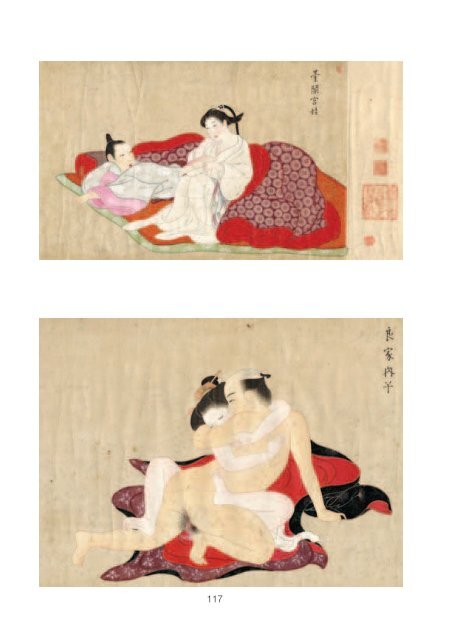Ukiyo-e - Kunsthandel Klefisch
Ukiyo-e - Kunsthandel Klefisch Ukiyo-e - Kunsthandel Klefisch
117
counters in London, often in the Prints Room of the British Museum, and in his Redhill house, after a lunch prepared by his kind wife Mary. A mark of Hillier’s gradual approach to a complete revaluation of shunga was the attention he gave to Hokusai’s erotic ehon in his book The Art of Hokusai in Book Illustration, 1980, in comparison with his previous monograph of 1955 on the great artist. In 1980 he managed to publish in Italy the first general book about erotic prints, Shunga. L’arte erotica popolare giapponese in 180 stampe dei suoi artisti piu insigni, whose publisher was Savelli in Rome. A year before, in 1979, in a series of pocket books issued by the same publisher, I had edited a monograph about Utamaro in which I dedicated a large part of the illustrations to shunga, placing them on the same level of dignity as the great series of bijin-ga (portraits of female beauties) and as his precious books. This novelty upset an academic scholar of Japanese art, who expressed his disagreement, criticising the fact that I had raised shunga to the level of the prints of female beauties, in a review on a daily newspaper; but ten years later he too included shunga in his books. On the contrary, my book was appreciated by Federico Zeri, who praised it in a review in which he expressed his interest and esteem: it was subsequently included in his collection of writings Mai di traverso. Sometimes, unforeseeable external events change the course of history: this happened with the fortunes of shunga, and the event was Nagisa Oshima’s film Ai no korida (Empire of Senses), which appeared in 1976. In one of my first writings on shunga I compared this genre, for its aesthetic quality and artistic achievement (which perhaps were even superior) with the great examples of Greek Attic vase painting with red figures of the fifth and fourth centuries B.C., for instance by pottery decorators such as Douris, Makron and the painter of Antiphon. Well, Oshima’s film, which may rightly be regarded as a last great outcome of the shunga genre, also testifies to the great aesthetic heritage of this tradition in the present time. Undoubtedly Oshima, as an art director, is indebted to the influence of Donatien Alphonse de Sade, Bataille and the writer Yukio Mishima, almost as much as to the shunga tradition: Ai no korida had the great merit of inducing the public to regard pornography, if expressed with high formal and visual standards, as a major, not inferior, artistic genre. And though Lane had already carried out his crucial study of revaluation of shunga, in the essay published also in German in the book Die Erotische Kunst des Ostens, edited by P. Rawson, in 1969 (parallelly to the studies of Howard Hibbet, The Floating World in Japanese Fiction, 1959, and Donald Keene, World within Walls. Japanese Literature of the Pre-Modern Era 1600-1867, 1976), Oshima’s film had the crucial merit of introducing the great public of the cinema to the appreciation of the aesthetic qualities of erotism. The second critical event for a new approach to shunga consisted in the great exhibition at the Musee d’Ixelles, in Brussels, from October to December 1989.
- Seite 1: Asiatische Kunst Auktion 84
- Seite 4 und 5: Repräsentanzen · Represantations
- Seite 6 und 7: VERSTEIGERUNGSBEDINGUNGEN 1. Frau T
- Seite 8 und 9: 6. The highest bidder will be deeme
- Seite 10 und 11: Katalogbearbeitung: Netsuke: Trudel
- Seite 12 und 13: KUNSTHANDEL KLEFISCH GMBH Ubierring
- Seite 14 und 15: 193
- Seite 17 und 18: Shunga, the Prints of Eternal Youth
- Seite 19: It was not by chance that Einstein
- Seite 23 und 24: It is not fitting for me, here, to
- Seite 25 und 26: Shunga: Die Drucke ewiger Jugend Ma
- Seite 27 und 28: sai, auf welche Bing (1896) und Hol
- Seite 29 und 30: Auf der anderen Seite war ich, als
- Seite 31 und 32: fast genau so verpflichtet, wie der
- Seite 33 und 34: Die nachfolgende Sammlung von Ehon
- Seite 35 und 36: Fukibokashi Schattierung der Farben
- Seite 37 und 38: I. Shunga - Ehon 1 3 35
- Seite 39 und 40: I. Shunga - Ehon 5 6 37
- Seite 41 und 42: I. Shunga - Ehon chem Element die P
- Seite 43 und 44: 13 # 14 # I. Shunga - Ehon Kikukawa
- Seite 45 und 46: 15 I. Shunga - Ehon 43
- Seite 47 und 48: 15 I. Shunga - Ehon 45
- Seite 49 und 50: I. Shunga - Ehon 16 Kitagawa Utamar
- Seite 51 und 52: 17 I. Shunga - Ehon 17 17 18 18 18
- Seite 53 und 54: 20 I. Shunga - Ehon 51
- Seite 55 und 56: 23 I. Shunga - Ehon 53
- Seite 57 und 58: I. Shunga - Ehon 24 Kitagawa Utamar
- Seite 59 und 60: 25 I. Shunga - Ehon 57
- Seite 61 und 62: 28 I. Shunga - Ehon 59
- Seite 63 und 64: 30 Utagawa Kunisada, 1786- 1864.
- Seite 65 und 66: 30 I. Shunga - Ehon 63
- Seite 67 und 68: 32 I. Shunga - Ehon 3: Tsumebiki: M
- Seite 69 und 70: I. Shunga - Ehon 33 Utagawa Hiroshi
117



